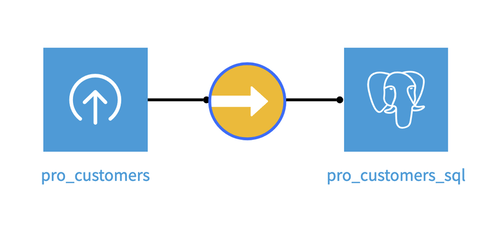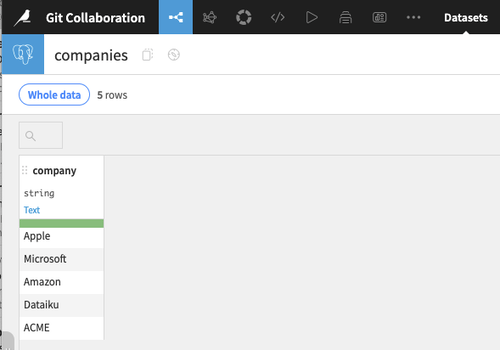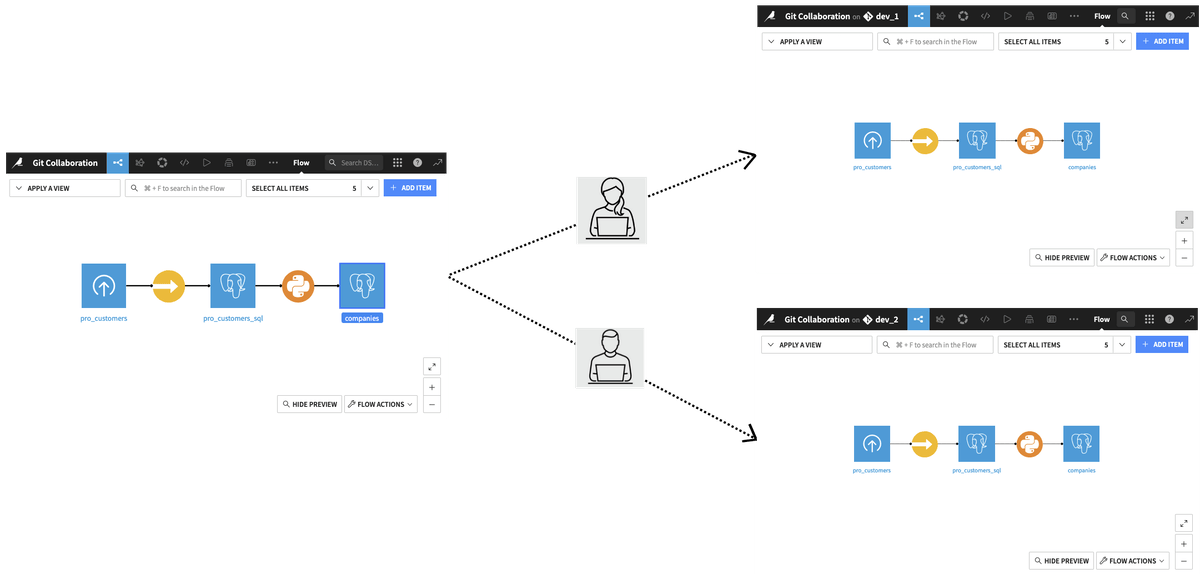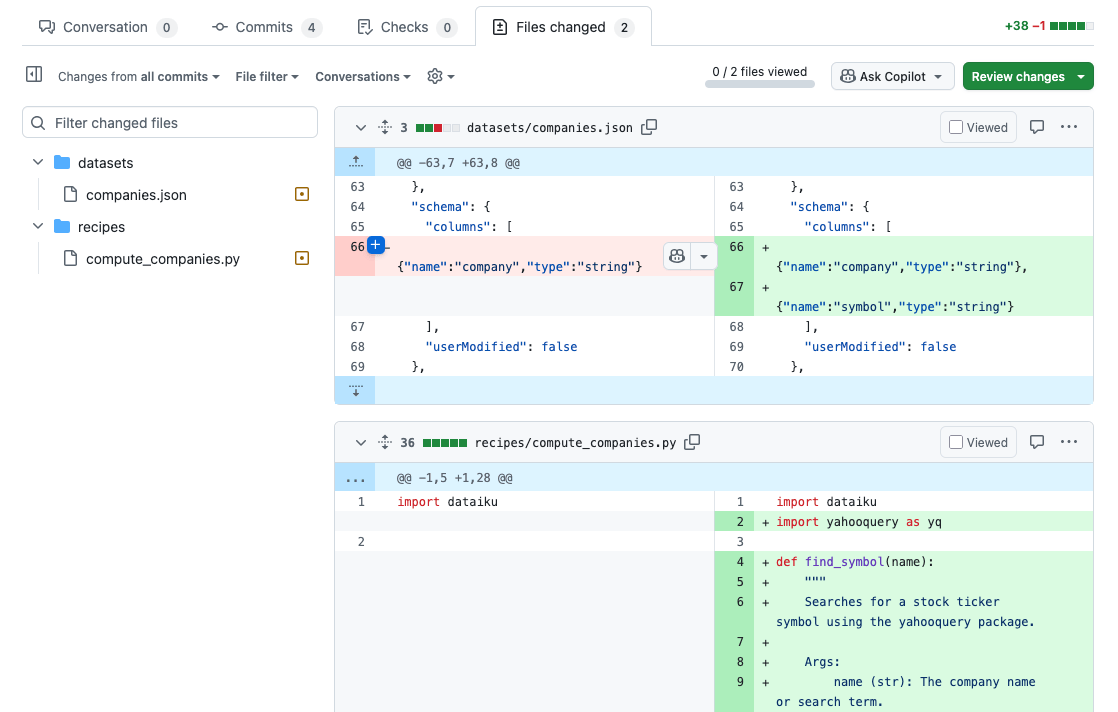Git collaboration#
This tutorial teaches you how to use Git integration within Dataiku in a multi-developer team use case. We are going to follow the story of a team of two developers in charge of a new project. Starting with a Dataset with customers information, a Dataset with companies information will be created. The first developer will add a column with the stock ticker symbol. The second developer will add a column with the last stock value. In both cases, they will use two libraries to help them: yfinance and yahooquery. It will show the different steps during a collaboration on a project, including operations like branching, creating a Pull Request, and handling a case of merge conflict.
Prerequisites#
Dataiku >= 13.5
Python >= 3.10
A code environment with the following packages:
yfinance #tested with 0.2.65 yahooquery #tested with 2.4.1
An SQL Dataset named
pro_customers_sql. You can create this Dataset by uploading thisCSV fileand using a Sync recipe to store the data in an SQL connection.
Preparing the project#
Before explaining the collaboration with branches, let’s prepare the project that will be used.
Set up the required Code Environment
In Administration > Code envs, select an existing Code Environment or click Create code environment, then add the libraries listed in the prerequisites section.
Once you have fulfilled the requirements, you will have a project with a flow with the uploaded file, a Sync recipe, and an SQL Dataset with the data from the CSV file.
For this tutorial, let’s call the SQL Dataset pro_customers_sql.

Fig. 1: Prepared project flow.#
Adding a Python recipe#
We are going to add a Python Code recipe from the SQL dataset (pro_customers_sql).
Go to the Advanced tab of the recipe to check you are using the Code Environment with the requirements installed.
We will create a new Dataset (named companies) containing only the company column.
For code implementation, you can use Code 1.
company column#import dataiku
# Read recipe input
pro_customers_sql = dataiku.Dataset("pro_customers_sql")
customers_companies = pro_customers_sql.get_dataframe(columns=['company'])
# Write recipe outputs
companies = dataiku.Dataset("companies")
companies_df = customers_companies.copy()
companies.write_with_schema(companies_df)
You now have a companies Dataset with the following content.

Fig. 2: Starting companies table.#
You can now add a remote repository, as described in the Git basics section. In summary, go to the Version Control menu and choose the Add remote action.
Creating the developer’s environments#
To collaborate on the project, let’s assume there are two developers. From the current state of the project, let’s create a branch for each of them. As described in the Branches operations, you will follow those steps:
From the Version Control menu, choose the branch menu currently showing the
mainbranch, and select Create new branch….Enter the branch name,
dev_1, and click the Next button.Click on the Duplicate and create branch button.
This will create the branch dev_1 for the first developer, who will use the duplicated project.
Return to the main project and repeat the sequence for the second developer (dev_2, for example).
We have the following collaboration architecture:

Fig. 3: Collaboration architecture.#
Each developer is going to work on a dedicated project and branch.
Adding and pushing code#
Adding and filling the symbol column.#
The first developer has to work on the following task: for each company in the companies Dataset, add the corresponding stock ticker symbol in a new column called symbol.
Code 2 shows how to modify the Python recipe.
import dataiku
import yahooquery as yq
def find_symbol(name):
"""
Searches for a stock ticker symbol using the yahooquery package.
Args:
name (str): The company name or search term.
Returns:
str: The ticker symbol if found, 'NA' if not found, or 'ERROR' on exception.
"""
try:
data = yq.search(name)
except ValueError:
return "ERROR"
else:
quotes = data['quotes']
if len(quotes) == 0:
return 'NA'
symbol = quotes[0]['symbol']
return symbol
# Read recipe input
pro_customers_sql = dataiku.Dataset("pro_customers_sql")
customers_companies = pro_customers_sql.get_dataframe(columns=['company'])
# Write recipe outputs
companies = dataiku.Dataset("companies")
companies_df = customers_companies.copy()
# For each company name, find the corresponding stock symbol
symbols = []
for company in companies_df['company']:
symbol = find_symbol(company)
if symbol not in ["ERROR", "NA"]:
symbols.append(symbol)
else:
symbols.append(None)
# Add the list of symbols as a new column 'symbol' in the DataFrame
companies_df['symbol'] = symbols
# writes the result to the dataset
companies.write_with_schema(companies_df)
Pushing the code#
Once satisfied with this new version of the project, the first developer decides to push the code.
To do so, go to the Version Control menu. From there, use the Push action.
The dev_1 branch now has this version of the project.
Creating a Pull Request#
As the branch has just been pushed, you can now navigate to Github and create a PR from the suggested Compare & pull request. You can also use the New pull request button from the Pull requests tab.

Fig. 4: Compare & pull request.#
Add all the needed elements, such as a description. You can see that two files were modified.

Fig. 5: Dev1 changed files.#
The file datasets/companies.json shows the modification done with the addition of the column symbol.
The file recipes/compute_companies.py shows the code modification done.
Merging changes in the main project#
The Pull Request view on GitHub shows that there is no conflict: you can merge your pull request. Once it is done, you can go back to your Dataiku instance and navigate to the main project. From the Version Control menu, choose the Pull action. The main project now has all the modifications by the first developer.
Working in the second environment#
You can switch to the environment created for the second developer.
Adding a stock value#
The second developer will now modify the Python recipe.
The developer must add a new column, last_stock, to the companies Dataset to store the last stock value retrieved using the yfinance package.
This can be done by using the following code in the compute_companies recipe:
import dataiku
import yahooquery as yq
import yfinance as yf
def find_symbol(name):
"""
Searches for a stock ticker symbol using the yahooquery package.
Args:
name (str): The company name or search term.
Returns:
str: The ticker symbol if found, 'NA' if not found, or 'ERROR' on exception.
"""
try:
data = yq.search(name)
except ValueError:
return "ERROR"
else:
quotes = data['quotes']
if len(quotes) == 0:
return 'NA'
symbol = quotes[0]['symbol']
return symbol
# Read recipe input
pro_customers_sql = dataiku.Dataset("pro_customers_sql")
customers_companies = pro_customers_sql.get_dataframe(columns=['company'])
# Write recipe outputs
companies = dataiku.Dataset("companies")
companies_df = customers_companies.copy()
# For each company name, find the corresponding last stock value
last_stocks = []
for company in companies_df['company']:
symbol = find_symbol(company)
if symbol not in ["ERROR", "NA"]:
try:
ticker_obj = yf.Ticker(symbol)
price = ticker_obj.history(period="1d")['Close']
latest_price = price.iloc[-1] if not price.empty else None
last_stocks.append(latest_price)
except Exception as e:
last_stocks.append(None)
else:
last_stocks.append(None)
# Add the list of last_stocks as a new column 'last_stock' in the DataFrame
companies_df['last_stock'] = last_stocks
# writes the result to the dataset
companies.write_with_schema(companies_df)
Creating the Pull Request#
The second developer will follow the same steps as the first one:
Push the code to the
dev_2branch from the Version Control menu of DataikuCreate a Pull Request from GitHub.
Note that conflicts have been detected this time.

Fig. 6: Dev2 conflict detected.#
Solving and merging changes in the main project#
You now have to solve the conflicts detected. You can do it with the tools you are the most comfortable with. For the purpose of this tutorial, we will use the tool proposed on GitHub from the PR view.

Fig. 7: Resolve conflicts button#
The conflict for the datasets/companies.json is solved by incorporating all modifications as shown below (don’t forget to add a , at the end of the first addition):

Fig. 8: Companies conflict solution.#
The conflict in the recipe code is a little trickier. You have to add the elements corresponding to the last_stock into the existing loop.
The final result is as the code below:
import dataiku
import yahooquery as yq
import yfinance as yf
def find_symbol(name):
"""
Searches for a stock ticker symbol using the yahooquery package.
Args:
name (str): The company name or search term.
Returns:
str: The ticker symbol if found, 'NA' if not found, or 'ERROR' on exception.
"""
try:
data = yq.search(name)
except ValueError:
return "ERROR"
else:
quotes = data['quotes']
if len(quotes) == 0:
return 'NA'
symbol = quotes[0]['symbol']
return symbol
# Read recipe input
pro_customers_sql = dataiku.Dataset("pro_customers_sql")
customers_companies = pro_customers_sql.get_dataframe(columns=['company'])
# Write recipe outputs
companies = dataiku.Dataset("companies")
companies_df = customers_companies.copy()
# For each company name, find the corresponding last stock value
last_stocks = []
symbols = []
for company in companies_df['company']:
symbol = find_symbol(company)
if symbol not in ["ERROR", "NA"]:
symbols.append(symbol)
try:
ticker_obj = yf.Ticker(symbol)
price = ticker_obj.history(period="1d")['Close']
latest_price = price.iloc[-1] if not price.empty else None
last_stocks.append(latest_price)
except Exception as e:
last_stocks.append(None)
else:
symbols.append(symbol)
last_stocks.append(None)
# Add the list of last_stocks as a new column 'last_stock' in the DataFrame
companies_df['last_stock'] = last_stocks
# Add the list of symbols as a new column 'symbol' in the DataFrame
companies_df['symbol'] = symbols
# writes the result to the dataset
companies.write_with_schema(companies_df)
You can commit the resulting merge. Your pull request for the second developer is now ready to be merged. You can merge into the main branch.
Wrapping up#
Congratulations! You are able to collaborate on a Dataiku project with a remote repository!
Reference documentation#
Classes#
|
Provides a handle to obtain readers and writers on a dataiku Dataset. |
Functions#
|
Read the dataset (or its selected partitions, if applicable) as a Pandas dataframe. |
|
Write a pandas dataframe to this dataset (or its target partition, if applicable). |

